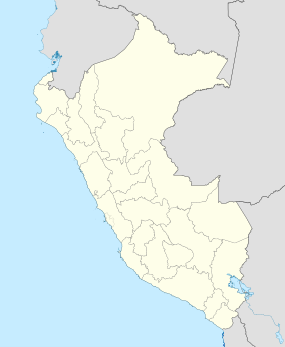Choquequirao
| Chuqi K'iraw | |

Truncated hill top at Choquequirao
|
|
| Location | Santa Teresa, La Convención Province, Cusco Region, Perú |
|---|---|
| Region | Andes |
| Coordinates | 13°23′34″S 72°52′26″W / 13.39278°S 72.87389°WCoordinates: 13°23′34″S 72°52′26″W / 13.39278°S 72.87389°W |
| Type | Settlement |
| Area | 18 km2 (6.9 sq mi) |
| History | |
| Founded | 1536 |
| Abandoned | 1572 |
| Cultures | Inca |
Choquequirao (in hispanicized spelling), Chuqi K'iraw or Chuqik'iraw (Quechua chuqi metal, every kind of precious metal/gold (<Aymara), k'iraw crib, cot, also spelled Choqek'iraw) is an Incan site in south Peru, similar in structure and architecture to Machu Picchu. The ruins are buildings and terraces at levels above and below Sunch'u Pata, the truncated hill top. The hilltop was anciently leveled and ringed with stones to create a 30 by 50 m platform.
Choquequirao (3,050 m) is in the spurs of the Vilcabamba mountain range in the Santa Teresa district, La Convención Province of the Cusco Region. The complex is 1,800 hectares, of which 30–40% is excavated.
The site is reached by a two-day hike from outside Cusco. Choquequirao has topped in the prestigious Lonely Planet's Best in Travel 2017 Top Regions list.
Choquequirao is a 15th and 16th century settlement associated with the Incan Empire, or more correctly Tahuantinsuyo. The site had two major growth stages. This could be explained if Pachacuti founded Choquequirao and his son, Tupac Inca Yupanqui, remodeled and extended it after becoming the Sapa Inca. Choquequirao is located in the area considered to be Pachacuti’s estate; which includes the areas around the rivers Amaybamba, Urabamba, Vilcabamba, Victos and Apurímac. Other sites in this area are Sayhuite, Machu Picchu, Chachabamba (Chachapampa), Choquesuysuy (Chuqisuyuy) and Guamanmarca (Wamanmarka); all of which share similar architectural styles with Choquequirao. The architectural style of several important features appears to be of Chachapoya design, suggesting that Chachapoya workers were probably involved in the construction. This suggests that Tupaq Inka probably ordered the construction. Colonial documents also suggest that Tupac Inca ruled Choquequirao since his great grandson, Tupa Sayri, claimed ownership of the site and neighboring lands during Spanish colonization.
...
Wikipedia

